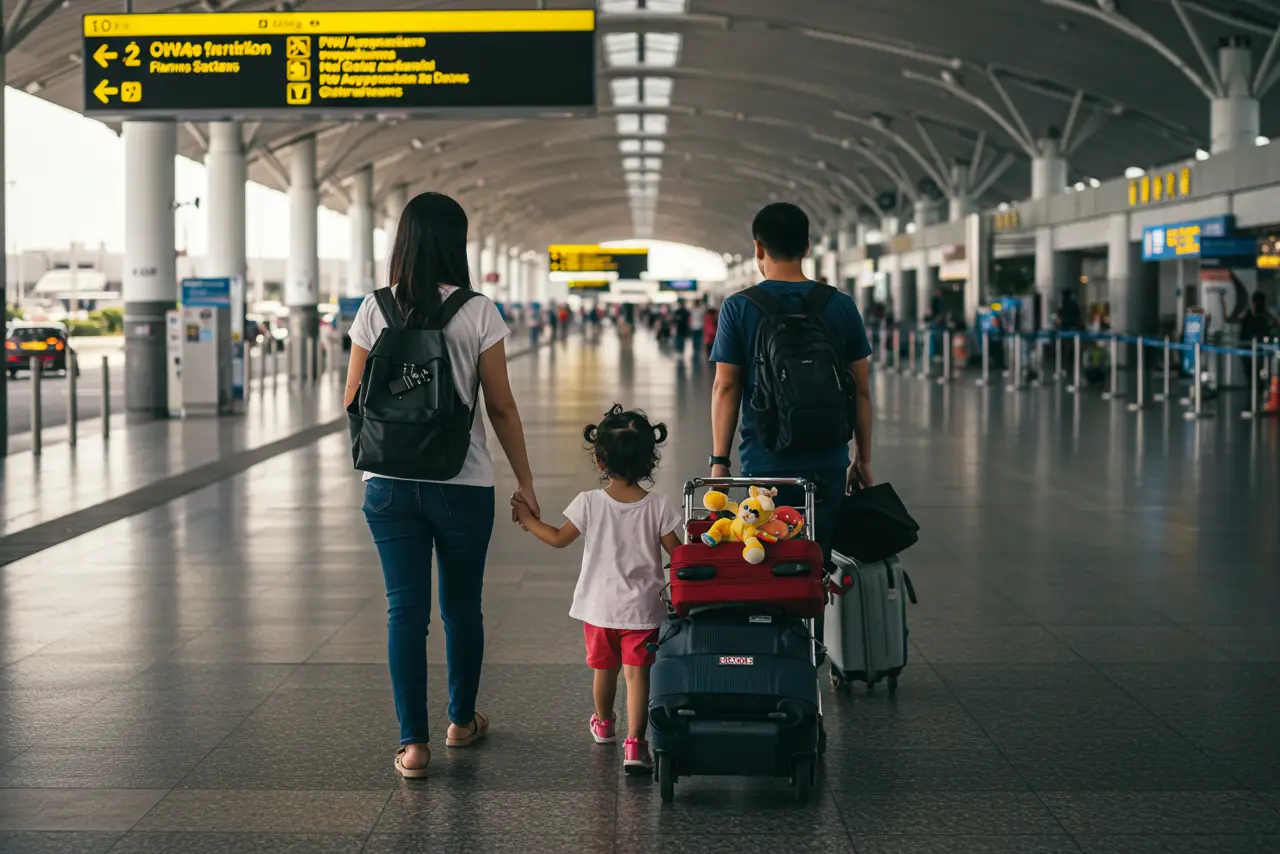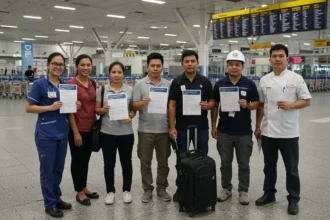New Zealand has quietly become one of the top choices for Filipinos looking to migrate. As of 2023, more than 100,000 Pinoys now live in New Zealand, making up around 2.2% of its population — proof that the Kiwi dream is alive and growing.
- 🛣️ Main Pathways to Work and Live in New Zealand
- ✨ Skilled Migrant Category Resident Visa (Step-by-Step Guide)
- 🏢 Accredited Employer Work Visa (AEWV) – Step-by-Step
- ✅ Green List & Direct Residency Pathways
- 🇵🇭 Special Programs for Filipinos
- 🎓 Student Visa → Work → Residency Pathway
- 👨👩👧 Bringing Family to New Zealand
- 💼 In-Demand Jobs for Filipinos in New Zealand
- 🌿 Lifestyle and Culture Shock: Life in New Zealand vs the Philippines
- 💸 Cost of Living Comparison: New Zealand vs the Philippines
- 📝 Step-by-Step Migration Game Plan
- ❓ Frequently Asked Questions (FAQs) About Migrating to New Zealand
- 🌟 Turning Your Kiwi Dream Into Reality
- 📚 References
For many, it’s not just about the jobs. The country is known for its clean environment, safe communities, and work-life balance — a lifestyle that appeals to Pinoys raising families. Unlike the hustle of Metro Manila, life in New Zealand offers shorter commutes, weekends outdoors, and strong public services like healthcare and education.
On top of this, New Zealand immigration for Filipinos is supported by programs actively seeking overseas talent, especially in healthcare, engineering, and IT. Whether through the Skilled Migrant Category NZ, the Accredited Employer Work Visa (AEWV), or the Green List fast-track jobs, opportunities are wide open for skilled Filipinos ready to take the leap.
This guide will walk you through the main work visa options, in-demand Filipino jobs in New Zealand, costs of living vs the Philippines, and what it’s like to settle with your family in Kiwi culture. We’ll teach you exactly how to migrate to New Zealand.

🛣️ Main Pathways to Work and Live in New Zealand
There’s no one-size-fits-all approach to migrating to New Zealand for Filipinos. Most Pinoys start with a temporary work visa and later transition to permanent residency, while others qualify directly for residency if they’re in highly demanded roles. Here are the main visa pathways you should know:
✨ Skilled Migrant Category Resident Visa
The Skilled Migrant Category (SMC) is the flagship pathway for skilled workers who want to become permanent residents. It uses a points-based system where applicants are assessed on age (must be under 55), qualifications, work experience, and job offers in New Zealand.
-
Having a job offer in New Zealand is a big advantage, often boosting your points enough for eligibility.
-
You’ll also need English language proficiency (IELTS or equivalent).
-
As of 2025, the government has tightened salary thresholds to match the median wage in New Zealand, so your offer must meet or exceed that level.
Once approved, this visa grants permanent residency — meaning you and your family can live, work, and study in NZ indefinitely.
🏢 Accredited Employer Work Visa (AEWV)
The Accredited Employer Work Visa (AEWV) is currently the most common work visa for Filipinos. Here’s how it works:
-
A New Zealand employer accredited by the government offers you a job.
-
You apply for the visa with proof of your qualifications, work history, and the job contract.
-
Visa durations usually range from 1–3 years, depending on the role.
This visa doesn’t give permanent residency right away, but it often serves as a stepping stone. If your role is on the Green List or if you’ve worked long enough with a stable employer, you can later apply for residency.
✅ Green List & Direct Residency Pathways
New Zealand maintains a Green List of in-demand jobs. Occupations like registered nurses, midwives, engineers, IT professionals, and construction managers are on this list.
-
Some jobs qualify for Straight-to-Residence, meaning you can apply for permanent residency as soon as you start working in NZ.
-
Others qualify for Work-to-Residence, where you work in NZ for 2 years in that role before applying for residency.
This is one of the fastest routes for Filipinos in high-demand fields like healthcare and engineering.
🌏 Special Programs for Filipinos
New Zealand recognizes the contribution of Filipino workers and has created special visa allocations in some fields:
-
100 nurses per year
-
20 engineers per year
-
20 farm managers per year
These quotas may be small, but they highlight just how much NZ values Filipino professionals.
🎓 Student Visa → Work → Residency
While not the primary route for most, studying in New Zealand is another option. By enrolling in a recognized program, you gain eligibility for a Post-Study Work Visa, which lets you work full-time after graduation. Many Filipinos who study in NZ eventually transition into residency through the Skilled Migrant Category or Green List jobs.
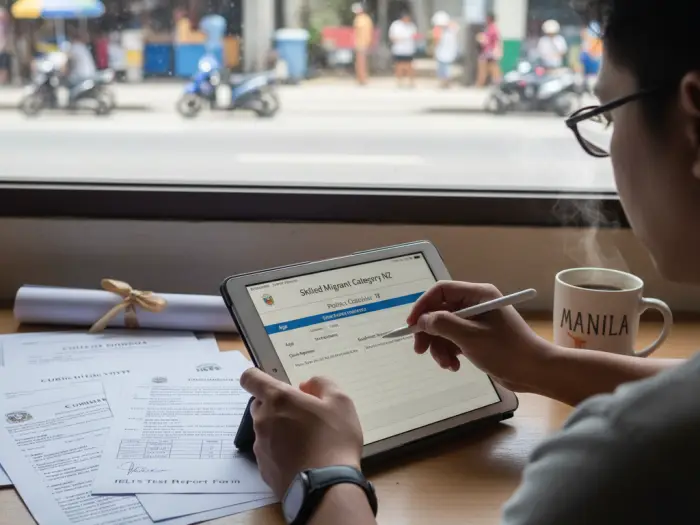
✨ Skilled Migrant Category Resident Visa (Step-by-Step Guide)
The Skilled Migrant Category (SMC) is the most direct way for Filipinos to secure permanent residency in New Zealand. It’s designed for people with valuable skills that NZ needs, and it’s points-based, meaning you’ll be assessed on age, work experience, education, and job offers.
1. Check Your Eligibility
-
Age limit: You must be under 55 years old when you apply.
-
English requirement: Proof of English (IELTS, TOEFL, or PTE Academic). Nurses and other regulated jobs often require higher scores.
-
Health & character: A medical exam and police clearances are mandatory.
-
Salary threshold: As of 2025, your job offer must usually meet or exceed the median wage in NZ to qualify.
2. Secure a Skilled Job Offer
-
Having a New Zealand job offer is often the deciding factor. It adds points and greatly improves your chances of selection.
-
Jobs on the Green List (like nurses, engineers, IT professionals) may fast-track your pathway to residence.
3. Submit an Expression of Interest (EOI)
-
You create an online profile with Immigration New Zealand (INZ), showing your skills, qualifications, and work offer.
-
EOIs are ranked, and those with enough points or in priority roles get invited to apply.
4. Invitation to Apply (ITA)
-
If your EOI is successful, you’ll receive an Invitation to Apply. This is where you submit detailed documents: diplomas, work references, English test results, etc.
5. Residency Application & Processing
-
Once your ITA is lodged, INZ reviews your case.
-
Processing times vary, but it often takes 6–12 months depending on demand and completeness of documents.
-
If approved, you and your immediate family (spouse, dependent kids) gain resident status with access to healthcare, education, and full work rights.
💡 Pinoy Tip
Many Filipinos succeed under SMC by boosting their credentials before applying — taking English tests again for higher scores, gaining extra work experience, or targeting jobs that are on NZ’s shortage lists.

🏢 Accredited Employer Work Visa (AEWV) – Step-by-Step
For many Filipinos working in New Zealand, the Accredited Employer Work Visa (AEWV) is the most common entry point. It’s designed for skilled workers who are hired by NZ employers accredited by the government. While it starts as a temporary visa, it can often lead to permanent residency if you stay in an in-demand role.
1. Get a Job Offer from an Accredited Employer
-
Your first step is securing a job offer from a New Zealand employer listed as “accredited” by Immigration NZ.
-
These employers have been approved to hire overseas workers because they’ve proven they can’t fill the role locally.
-
Job offers must meet minimum pay rates, often linked to the median wage (updated yearly).
2. Employer Completes a Job Check
-
Before you apply, your employer must pass a Job Check with Immigration NZ.
-
This proves the role is genuine and meets requirements (salary, job conditions, no exploitation).
-
Once approved, you get a Job Token reference to use in your application.
3. Apply for the AEWV
-
With the job offer and Job Token, you lodge your visa application.
-
Documents required: passport, job contract, proof of qualifications/experience, medicals, and police clearances.
-
Many Filipinos also include English test scores if the role requires them (especially healthcare).
4. Visa Duration & Conditions
-
AEWVs are generally valid for 1–3 years, depending on the role and salary level.
-
You must keep working for the same employer and in the role listed in your visa.
-
If your job is on the Green List, you may transition faster to residency through Straight-to-Residence or Work-to-Residence pathways.
5. Pathway to Residency
-
After gaining experience, many Filipinos on AEWVs apply for the Skilled Migrant Category or Work-to-Residence visas.
-
If your job stays in demand and your employer supports you, residency becomes achievable within a few years.
💡 Pinoy Tip
AEWV is often the easiest way for Filipinos to first enter New Zealand, especially in healthcare, engineering, and trades. Treat it as your stepping stone visa: work hard, prove your skills, and use it as a bridge toward permanent residency.

✅ Green List & Direct Residency Pathways
One of the fastest ways for Filipinos to become residents in New Zealand is through jobs listed on the country’s official Green List. This list highlights critical, high-demand occupations that New Zealand struggles to fill locally, and it comes with residency benefits.
🌟 Two Residency Options from the Green List
-
Straight-to-Residence: If your role is on Tier 1 of the Green List (e.g., registered nurse, midwife, certain engineering roles), you can apply for permanent residency as soon as you arrive and start working in NZ.
-
Work-to-Residence: If your job is on Tier 2 (e.g., secondary school teacher, construction project manager, some trades), you’ll need to work in New Zealand for 24 months before becoming eligible for residency.
📋 Examples of Green List Jobs for Filipinos
-
Healthcare: Registered nurses, midwives, medical laboratory scientists, and aged care workers.
-
Engineering: Civil, electrical, mechanical, structural, and geotechnical engineers.
-
Information Technology (IT): Software engineers, cybersecurity specialists, ICT project managers.
-
Construction & Infrastructure: Quantity surveyors, project managers, surveyors, and certain specialist trades.
-
Education: Secondary school teachers in sciences, technology, and special education.
🔑 Why It Matters for Filipinos
Filipinos are already excelling in these sectors — particularly healthcare and engineering — making the Green List an ideal pathway. For instance:
-
Nurses from the Philippines can bypass long residency waits and apply for PR almost immediately.
-
Engineers with international experience often secure Work-to-Residence and later transition smoothly to PR.
-
IT professionals, one of the fastest-growing Filipino talent pools, are heavily favored in New Zealand’s skill shortage system.
💡 Pinoy Tip
If your profession is on the New Zealand Green List, prioritize getting a job offer that matches the listed requirements (qualification, registration, salary level). This can cut your migration timeline from years down to months.

🇵🇭 Special Programs for Filipinos
New Zealand has long recognized the contribution of overseas workers, and Filipinos are no exception. In fact, there are specific visa allocations designed just for Pinoys in certain critical fields.
📌 Annual Special Work Visa Allocations
-
100 Registered Nurses – reflecting New Zealand’s urgent need for healthcare staff. Filipino nurses are highly regarded for their training and English proficiency.
-
20 Engineers – civil, mechanical, and electrical engineers are particularly valued in New Zealand’s growing infrastructure projects.
-
20 Farm Managers – agriculture remains a backbone of the NZ economy, and Filipino farm managers are increasingly sought after for their skills and experience.
These quotas may look small, but they highlight how much New Zealand trusts Filipino professionals in vital industries. If you belong to one of these fields, you may have a faster, more straightforward path to working and living in New Zealand.
💡 Pinoy Tip
Even if you’re not in these special quota categories, don’t worry. Many Filipinos enter through the Accredited Employer Work Visa (AEWV) or other skilled pathways, then transition to residency later. What matters most is securing a job offer in an in-demand role.

🎓 Student Visa → Work → Residency Pathway
For some Filipinos, the most strategic way to build a future in New Zealand is by starting as an international student. While it requires higher upfront costs, it can open doors to long-term work opportunities and eventually permanent residency.
1. Study in a Recognized Institution
-
Enroll in a Designated Learning Institution (DLI) in New Zealand that qualifies you for a Post-Study Work Visa.
-
Popular choices for Pinoys include programs in IT, healthcare, engineering, and business, since these fields align with New Zealand’s skill shortages.
-
Tuition fees range from NZ$12,000–$25,000 per year depending on the program and location.
2. Work While Studying
-
As a student visa holder, you can work up to 20 hours per week during school terms, and full-time during scheduled breaks.
-
This helps cover living expenses and gain valuable work experience in New Zealand. Many Filipinos use part-time jobs in hospitality, retail, or caregiving while studying.
3. Post-Study Work Visa (PSWV)
-
After completing your course, you can apply for a Post-Study Work Visa, which allows you to work in New Zealand for up to 3 years (depending on the length of your study program).
-
During this period, you can seek full-time jobs in your field — an essential step toward gaining the experience needed for residency applications.
4. Transition to Permanent Residency
-
Once you have at least 1–2 years of skilled work experience in NZ, you become eligible for residency under the Skilled Migrant Category or Work-to-Residence visa (if your job is on the Green List).
-
Having studied and worked locally gives you an advantage, since Kiwi employers and Immigration NZ recognize New Zealand credentials highly.
💡 Pinoy Tip
For Filipinos who can afford the upfront cost, the study-to-residency pathway is one of the most reliable routes. Not only do you earn a recognized qualification, but you also integrate into Kiwi work culture and build a network, making it easier to secure skilled employment after graduation.
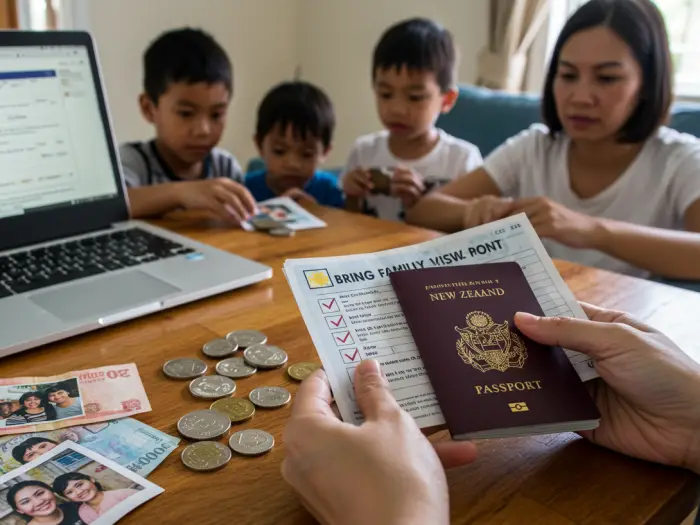
👨👩👧 Bringing Family to New Zealand
For most Pinoys, the dream of migrating is not just about finding work abroad — it’s about building a better life together with their families. The good news is that many New Zealand work visas allow you to bring your spouse and children, provided you meet the income and visa conditions.
Dependent Visas for Spouse and Children
-
If you’re on a Skilled Migrant Category Resident Visa, your spouse and dependent children are included in your application, making them residents at the same time as you.
-
If you’re on an Accredited Employer Work Visa (AEWV) or another long-term work visa:
-
Spouse/partner may qualify for an open work visa, allowing them to work for any employer in NZ.
-
Children can usually get student visas. In some cases, they may even pay domestic (not international) tuition fees if you hold a qualifying work or resident visa.
-
Education and Healthcare for Families
-
Schooling: Children of work visa holders can often attend public schools, which provide high-quality education.
-
Healthcare: Full healthcare benefits are available once you or your family obtain residency. Some work visas also allow access to limited healthcare services, but many Pinoys choose to get private health insurance in the meantime.
Financial Requirements
-
Immigration NZ requires proof that you earn enough to support your family without government assistance.
-
For AEWV holders, this often means earning at or above the median wage threshold, which is updated yearly.
💡 Pinoy Tip
Bringing family early helps with emotional adjustment, but it can also mean higher initial expenses. Many Filipinos choose to move first on their own, establish stable work and housing, then bring their family after a year. Others move together right away for quicker settlement.

💼 In-Demand Jobs for Filipinos in New Zealand
Filipinos are highly valued in New Zealand for their skills, English proficiency, and strong work ethic. Many industries are actively recruiting Pinoys, especially in areas listed on the NZ Green List or those facing ongoing shortages.
🏥 Healthcare Professionals
-
Roles: Registered nurses, midwives, aged care workers, caregivers, medical laboratory technicians.
-
Why Filipinos fit: Strong training in the Philippines, English fluency, and global demand for Filipino nurses.
-
Salary Range: ₱160,000 – ₱300,000 per month depending on experience and specialization.
-
Requirement: Nurses must register with the Nursing Council of New Zealand and pass English language exams (e.g., IELTS Academic).
🏗️ Engineering and Skilled Trades
-
Roles: Civil, electrical, and mechanical engineers, plus welders, electricians, plumbers, and carpenters.
-
Why Filipinos fit: Proven track record in construction and infrastructure projects both in PH and abroad.
-
Salary Range: ₱176,000 – ₱280,000 per month for engineers; trades earn around ₱140,000 – ₱200,000 per month.
-
Requirement: Some roles may need NZ professional registration or licensing.
💻 Information Technology (IT)
-
Roles: Software engineers, cybersecurity specialists, systems analysts, ICT project managers.
-
Why Filipinos fit: The Philippines produces many skilled IT graduates, and NZ’s tech sector is rapidly growing.
-
Salary Range: ₱200,000 – ₱350,000 per month, depending on role and seniority.
-
Requirement: Relevant degrees and work experience, sometimes industry certifications.
📚 Education and Teaching
-
Roles: Early childhood educators, primary and secondary school teachers (especially in math, sciences, and special education).
-
Why Filipinos fit: Many Filipino teachers already teach in English-medium schools and adapt well to NZ classrooms.
-
Salary Range: ₱150,000 – ₱230,000 per month.
-
Requirement: Teachers must register with the Teaching Council of Aotearoa New Zealand and may need extra coursework for local alignment.
🍴 Tourism & Hospitality
-
Roles: Chefs, hotel staff, tourism managers, and front-line service staff.
-
Why Filipinos fit: Strong hospitality culture and overseas experience (e.g., cruise ships, hotels abroad).
-
Salary Range: ₱120,000 – ₱200,000 per month depending on role and location.
-
Requirement: Relevant work experience; chef roles may require trade certification.
🌾 Agriculture and Farming
-
Roles: Farm managers, veterinarians, dairy workers, and horticulture specialists.
-
Why Filipinos fit: Many Pinoys have backgrounds in agri-business and hands-on farm management.
-
Salary Range: ₱130,000 – ₱210,000 per month.
-
Requirement: Farm managers often need prior leadership experience; some roles are included in NZ’s special visa allocation for Filipinos.
💡 Pinoy Tip
If you’re serious about working in New Zealand as a Filipino, check the Green List jobs first. Being in one of these roles can dramatically shorten your pathway to residency — sometimes even granting Straight-to-Residence status.
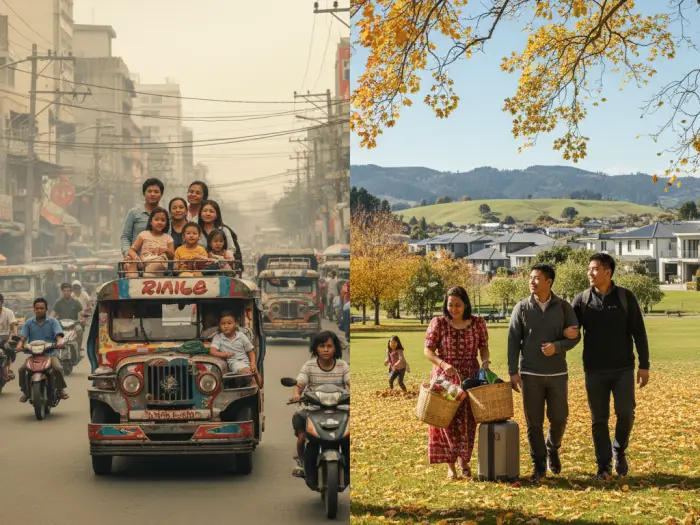
🌿 Lifestyle and Culture Shock: Life in New Zealand vs the Philippines
Migrating is more than just getting a visa — it’s about adjusting to a new way of life. For Filipinos in New Zealand, the shift can be exciting but also surprising. Here’s what to expect when you trade life in the Philippines for Kiwi living.
🕒 Work–Life Balance
In New Zealand, people work hard but also know when to rest. A standard full-time job is usually 40 hours per week, and overtime is rare compared to the Philippines where long hours are common. Kiwis value work–life balance, so expect weekends for family, hobbies, and outdoor adventures instead of endless late nights at the office.
🤝 Cultural Differences
Filipinos are used to hierarchy and formality in workplaces, but Kiwi culture is flat and informal. It’s normal to call your boss by their first name, and decisions are often made collaboratively. At first, Pinoys may find Kiwis reserved, but once friendships form, they’re genuine and lasting.
🏘️ Community Support
With over 100,000 Filipinos in New Zealand, you’ll find Filipino associations, fiestas, and even Jollibee branches to remind you of home. These groups help newcomers adjust, offering everything from job advice to social support. The Filipino community in New Zealand is one of the fastest-growing migrant groups, so you’ll never feel alone.
🌤️ Climate & Environment
Say goodbye to tropical heat — New Zealand has four distinct seasons. Winters can get chilly, especially in the South Island, so pack jackets and learn to love layering. On the bright side, the clean air, mountains, and parks will make you fall in love with outdoor living. Hiking, picnics, and road trips become part of your lifestyle.
🗣️ Language & Kiwi Slang
English is the main language, so Filipinos usually adjust quickly. But get ready for Kiwi slang:
-
“Sweet as” means everything’s good.
-
“Togs” are swimwear.
-
“Jandals” are what we call slippers or tsinelas.
It may sound odd at first, but you’ll pick it up in no time.
💸 Cost of Living Adjustments
This is the biggest shock for many Pinoys. According to comparisons, the cost of living in New Zealand is 2–3 times higher than in the Philippines. Rent is especially steep: a one-bedroom apartment in Auckland may cost ₱40,000–₱60,000 per month. Groceries and dining out are also pricier, though salaries are much higher to balance it out. Transport is car-centric in many areas, but traffic is far lighter than in Metro Manila.
💡 Pinoy Tip
Expect an adjustment period of 6–12 months. Embrace Kiwi habits like budgeting weekly for groceries, spending time outdoors, and calling people by their first name. These small shifts help Filipinos settle into the life in New Zealand faster and with less stress.
💸 Cost of Living Comparison: New Zealand vs the Philippines
One of the biggest adjustments for Filipinos migrating to New Zealand is the cost of living. While salaries in NZ are much higher than in the Philippines, so are expenses. Understanding this comparison helps Pinoys budget better and avoid financial surprises.
🏠 Housing
-
New Zealand: Renting a one-bedroom apartment in central Auckland or Wellington costs around ₱40,000–₱60,000 per month. Outside the city centers, it may drop to ₱30,000–₱45,000.
-
Philippines: The same in Metro Manila would cost ₱12,000–₱25,000 depending on the area.
🥗 Food & Groceries
-
New Zealand: Grocery prices are about 2x higher than in the Philippines. A kilo of chicken is ₱350–₱400, while eating out in a mid-range restaurant can cost ₱1,000–₱1,500 per person.
-
Philippines: A kilo of chicken is around ₱180–₱220, and a casual meal is only ₱150–₱250.
🚗 Transportation
-
New Zealand: Public transport in big cities (bus, train) costs ₱150–₱200 per ride, but many people buy cars. Fuel is pricier at around ₱90–₱100 per liter.
-
Philippines: Jeepneys, tricycles, and buses keep costs low — usually ₱20–₱50 per ride, and gasoline averages ₱65–₱70 per liter.
🏥 Healthcare & Education
-
New Zealand: Healthcare becomes free once you’re a resident, but work visa holders often need private insurance (₱5,000–₱10,000 per month). Public schools are free for residents’ children, but international fees apply if you’re on a short-term visa.
-
Philippines: Private healthcare and tuition are much cheaper, but the quality of NZ’s public services is far higher once you qualify.
📊 Comparison Table – Cost of Living (Monthly Averages)
| Expense Category | New Zealand (₱) | Philippines (₱) |
|---|---|---|
| Housing (1BR rent) | 40,000 – 60,000 | 12,000 – 25,000 |
| Groceries (per month) | 25,000 – 40,000 | 12,000 – 18,000 |
| Eating Out (per meal) | 1,000 – 1,500 | 150 – 250 |
| Transport (commute) | 6,000 – 10,000 | 2,000 – 4,000 |
| Gasoline (per liter) | 90 – 100 | 65 – 70 |
| Health Insurance | 5,000 – 10,000 | 1,500 – 3,000 |
| School (per child) | Free (residents) / 40k+ (non-residents) | 5,000 – 15,000 private |
💡 Pinoy Tip
While the cost of living in New Zealand is 2–3 times higher than in the Philippines, the average monthly salary in NZ is also ₱150,000+, compared to only ₱19,000 in PH. This means Filipinos can still save more, provided they manage their budgets wisely.
📝 Step-by-Step Migration Game Plan
Migrating to New Zealand can feel overwhelming, but breaking it down into clear steps makes the journey more manageable. Here’s a roadmap Pinoys can follow to turn the Kiwi dream into reality:
1. Assess Your Qualifications
-
Check if your job is on the New Zealand Green List or if you’re eligible under the Skilled Migrant Category NZ.
-
If you don’t meet requirements yet, consider upskilling (extra training, certifications, or English tests like IELTS).
2. Research Job Opportunities
-
Explore NZ-accredited employers hiring Filipinos through official websites (immigration.govt.nz, workhere.nz).
-
Healthcare, IT, engineering, and trades are the most common Filipino jobs in New Zealand.
3. Secure a Job Offer (or Study Plan)
-
A job offer from an accredited employer is the strongest foundation for an AEWV.
-
If a job offer is hard to get, consider the student visa pathway to enter NZ, study, and then transition into work.
4. Apply for the Right Visa
-
Gather documents: updated CV (NZ format), certificates, transcripts, police clearances, medicals.
-
Apply online through Immigration NZ, or work with legit agencies (avoid “fixers” who promise instant jobs).
5. Plan Your Finances & Proof of Funds
-
Budget at least ₱200,000–₱400,000 for initial costs (visa, airfare, settlement).
-
If moving with family, save more to cover rent, schooling, and health insurance until you get residency.
6. Prepare for Kiwi Life
-
Learn about the cost of living in New Zealand vs Philippines. Rent and groceries are higher, but salaries balance it out.
-
Adjust expectations: shorter commutes, more leisure time, but also four seasons and colder weather.
7. Bring Your Family (When Ready)
-
Decide whether to migrate first and bring them later, or move together if financially ready.
-
Many work visas allow spouses to get open work permits and kids to attend public schools.
8. Settle & Grow in New Zealand
-
Connect with the Filipino community in New Zealand — they’re your support system abroad.
-
Build local experience, improve English if needed, and work toward residency or citizenship for long-term security.
💡 Pinoy Tip: Think of migration as a marathon, not a sprint. Many successful Filipinos in New Zealand started small — as caregivers, hospitality workers, or students — before climbing to skilled roles and permanent residency. With patience, budgeting, and determination, you’ll get there too.
❓ Frequently Asked Questions (FAQs) About Migrating to New Zealand
1. Can Filipinos migrate to New Zealand without a job offer?
Yes, but it’s harder. Most Pinoys migrate through a New Zealand work visa like the AEWV, which requires a job offer. The Skilled Migrant Category NZ may also be possible if you meet the points and salary thresholds.
2. What are the in-demand Filipino jobs in New Zealand?
Healthcare (nurses, caregivers), IT, engineering, teaching, and skilled trades are the most common Filipino jobs in New Zealand. Many of these roles are on the Green List, which can lead to faster residency.
3. How much is the salary in New Zealand for Filipinos?
On average, Pinoys working in skilled roles earn ₱150,000–₱300,000 per month, depending on the industry. This is much higher than Philippine salaries, even after considering the higher cost of living in New Zealand vs Philippines.
4. Can I bring my family to New Zealand on a work visa?
Yes. Most NZ work visas for Filipinos allow you to bring your spouse and dependent children. Spouses often get open work visas, while children can study in public schools (sometimes free if your visa qualifies).
5. Is IELTS required for Filipinos to work in New Zealand?
For most skilled roles, yes. Nurses, teachers, and engineers typically need proof of English (IELTS or equivalent). However, some employers may waive this if you have extensive English-medium education or work experience.
6. What is the easiest way for Filipinos to migrate to New Zealand?
The Accredited Employer Work Visa (AEWV) is the most common entry point. If your job is on the New Zealand Green List jobs, you may even qualify for Straight-to-Residence.
7. How long does it take to get residency in New Zealand?
It depends on the pathway. Under the Skilled Migrant Category, it may take 6–12 months after applying. With Green List Straight-to-Residence, Filipinos can apply immediately after getting the job.
8. What is the cost of living in New Zealand compared to the Philippines?
Living in NZ is about 2–3x more expensive. Rent in Auckland can reach ₱40,000–₱60,000 per month, but salaries are high enough to cover costs and still save.
9. Can Filipinos apply for New Zealand student visas?
Yes. Many choose the student visa to PR pathway: study in NZ, work under the Post-Study Work Visa, then transition to residency. This route is popular but requires higher upfront investment.
10. Is there a Filipino community in New Zealand?
Absolutely. With over 100,000 Pinoys in New Zealand, there are active Filipino associations, fiestas, and support groups in cities like Auckland, Wellington, and Christchurch.
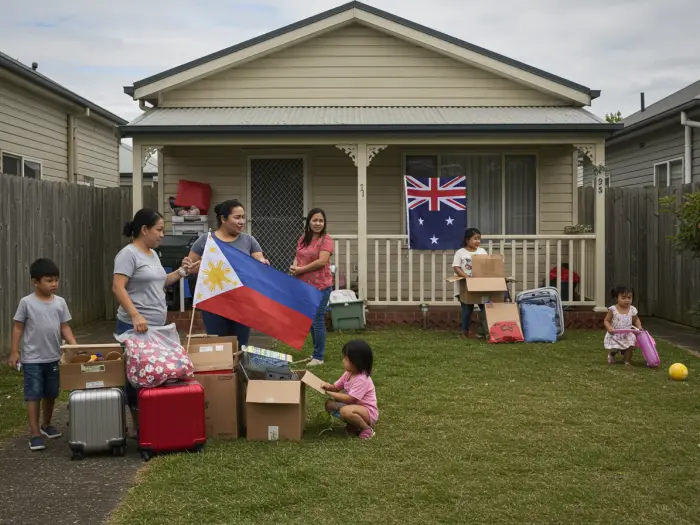
🌟 Turning Your Kiwi Dream Into Reality
For many Filipinos, migrating to New Zealand is more than a career move — it’s a chance to build a safer, healthier, and more balanced life for the whole family. With clear visa options like the Skilled Migrant Category NZ, the Accredited Employer Work Visa (AEWV), and the Green List jobs, Pinoys today have more opportunities than ever to make this dream possible.
Yes, the cost of living in New Zealand vs the Philippines is higher, and the journey may require patience, funds, and paperwork. But the reward — stable jobs, world-class education for your children, access to healthcare, and a strong Filipino community in New Zealand — makes every sacrifice worthwhile.
If you’re ready to start, take the first step: research your in-demand skills, prepare your documents, and apply with confidence. Thousands of Pinoys have already made the move, and you could be next. Your Kiwi future is waiting — all it takes is courage, preparation, and determination.



